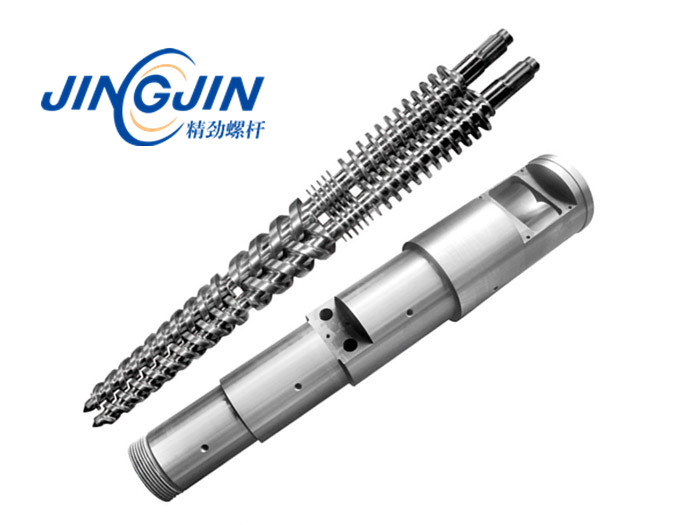During the extrusion process, the surface of the screw […]
During the extrusion process, the surface of the screw and the inner wall of the barrel are affected by material wear and corrosion. The gap between the two increases, which reduces the extrusion rate and seriously affects the service life of the machine. This article mainly introduces the measures to prevent screw wear and corrosion and the measurement after screw wear and corrosion.

1. Introduction
The extruder screw is working under the conditions of high temperature, strong corrosion, strong wear and high torque. The surface of the screw and the surface of the inner wall of the barrel are often worn and corroded to varying degrees. Worn screw and barrel are usually attributed to improper design and manufacturing.
That is
(1) the tolerance is inappropriate;
(2) Bending caused by the release of internal stress in the screw;
(3) Misalignment of screw and barrel after assembly:
(4) The assembly of the transmission mechanism is loose.
In addition, in the extrusion process, the material is also very important to the wear and corrosion of the screw and barrel. For example, PVC materials are easily degraded by overheating and emit corrosive gases; glass fiber reinforced nylon, in addition to severe abrasion, has strong chemical corrosion. This is because the glass fiber adheres to the silicone as a treatment agent. When the processing temperature exceeds a certain temperature, the mailing silicon decomposes, causing corrosion on the surface of the screw and barrel. As a result, the gap between the screw and the barrel increases, the leakage flow rate increases, and productivity decreases. When δ/hs=15% and QL/QP=37%, the screw is charged. (δ~clearance, hs~the depth of the groove in the homogenization section, QL~the leakage flow, QP~reverse flow).

2. Choose appropriate measures to reduce screw wear and corrosion
In the plastics processing industry, the selection of reasonable assembly structure and the processing accuracy of components; the correct design of the screw structure and the use of new materials and surface treatment are effective measures to reduce the wear and corrosion of the screw surface and increase productivity.
(1) Reasonably select the processing accuracy of assembly plums and parts.
Finely process parts such as screws and barrels to improve their accuracy and reduce accumulated errors; use reasonable connection methods to assemble them together. The gap between the two should not be too large or too small, and keep it properly to prevent grinding or reduce productivity. The clearance value (mm) between the stalk and the barrel in my country is recommended as follows.
(2) Design the structural shape of the screw thread correctly.
Reasonably designing the structural shape of the thread is one of the effective ways to reduce wear. The Raleigh stepped screw thread is designed on the basis of analyzing the causes of wear and is two more suitable thread formations. The thread configuration of the Raleigh stepped bearing surface is two parallel sections. The pressure gradient of the two sections is constant, the pressure distribution is triangular, and the maximum pressure is at the step. This thread structure improves the material carrying capacity of the thread and ensures that there is a layer of molten film between the gaps. For example, on a screw with a diameter of 150mm, when the width of the screw tip is 20mill and the thread gap (h.) is 0.15mm, the optimal thread parameter range is h1/h0=1. 8 and B1/B. = 2.5. If the polymer’s power law constant η=25KNSm/m2 and n=0.25, when the screw stalk rotates at 100 rpm, and each eccentricity of 0.01mm, the reducing force acting on one pitch of the screw will be 3.9KN .
At the screw with conical screw top structure, the melt flow flows in the tangential direction. The scraping action of the thread will not damage the melting film. For example, for a screw with a thread width of 20 ram and a gap of 0.15 mm, the best screw top configuration is h/h0=2.2 and B/B. = 5. When the screw speed is 100 rpm and the eccentricity is 0.01 mm, the reducing force acting on each pitch is 3.8 KN.
(a) Cone screw top and pressure distribution
(b) Screw with taper top thread
(3) Reasonable treatment of the screw surface
Selecting screws and barrels with high surface hardness and strong corrosion resistance is an important way to reduce wear and corrosion, improve productivity, and increase service life. Therefore, it is necessary to choose better steel for manufacturing or screw surface treatment. For example, alloy steel has better comprehensive performance after nitriding treatment, so it is widely used. In addition to chromium plating or nitriding treatment for screw sweat, alloy can also be sprayed on the surface of the screw.